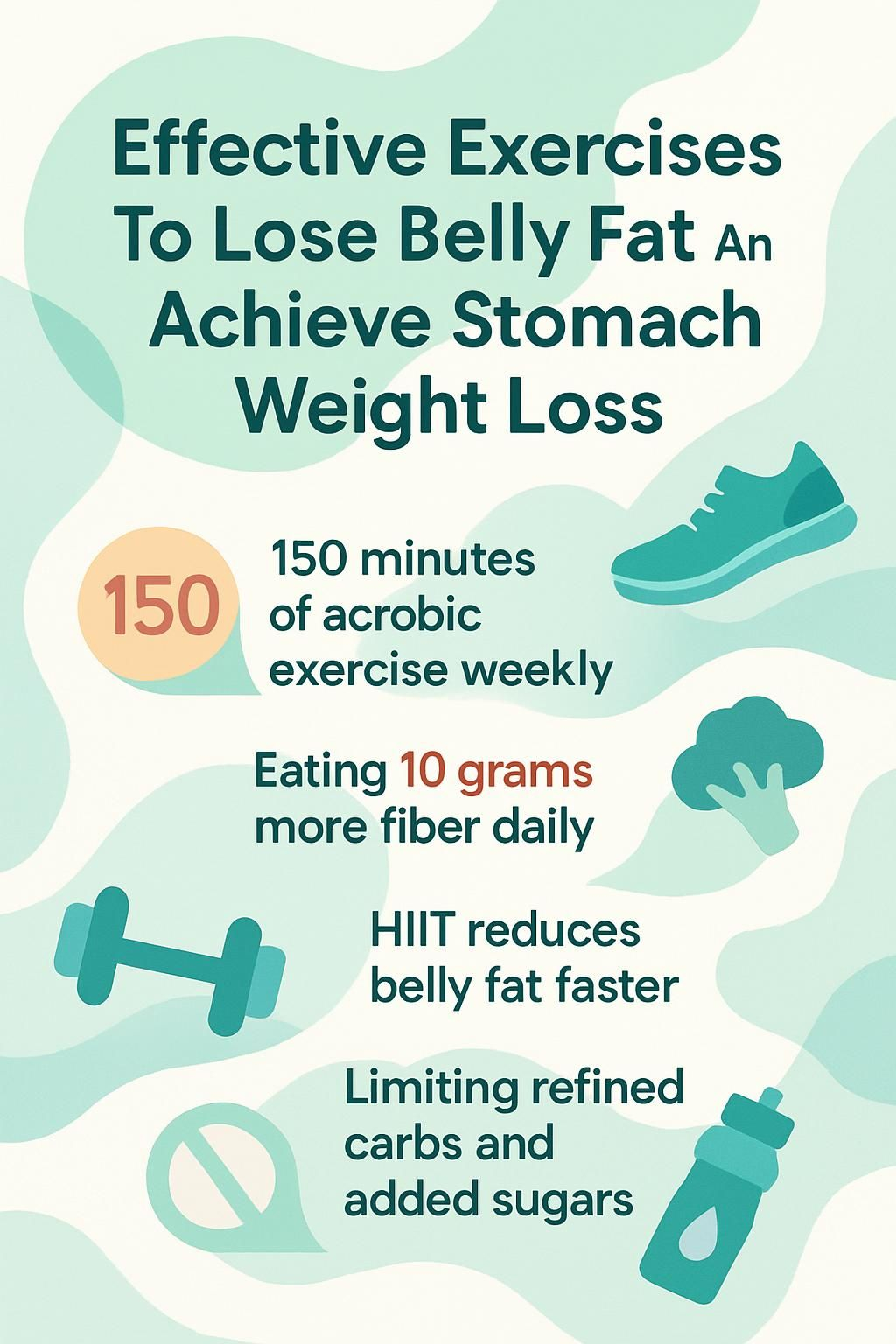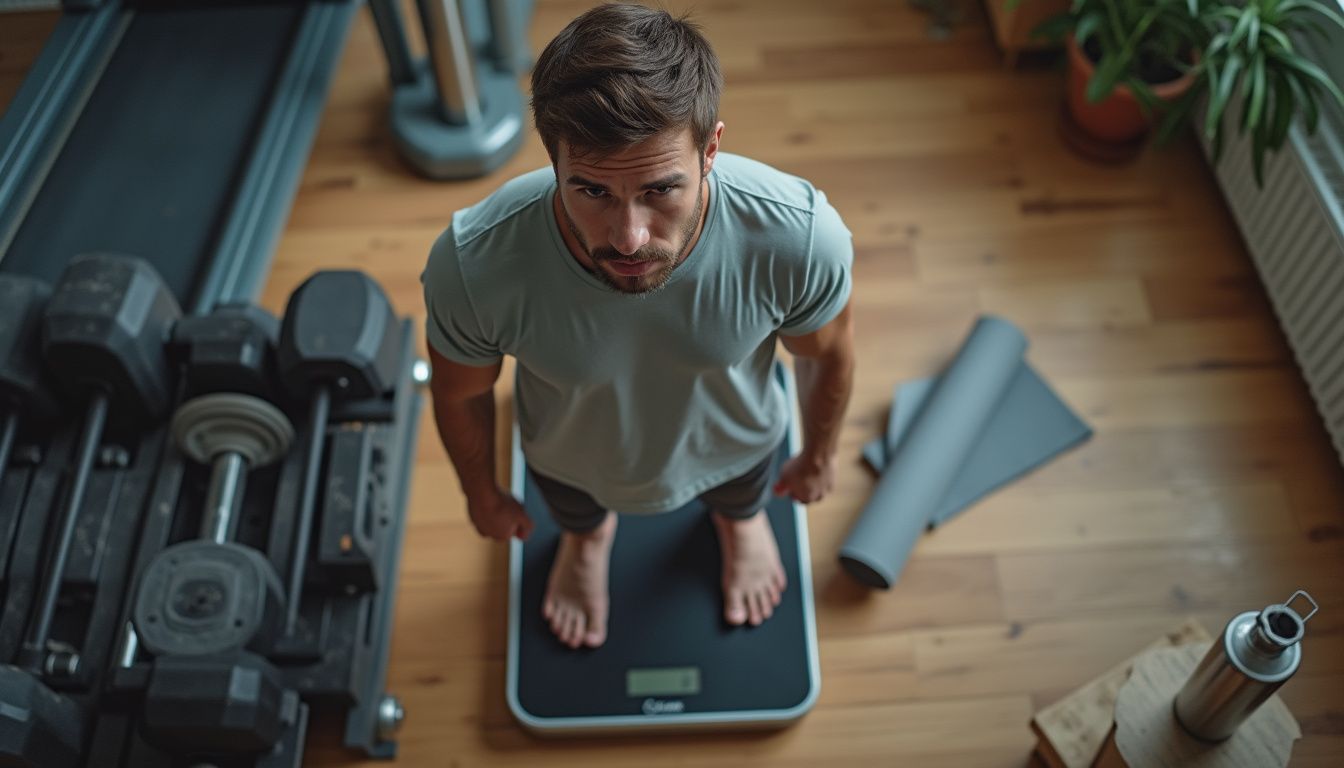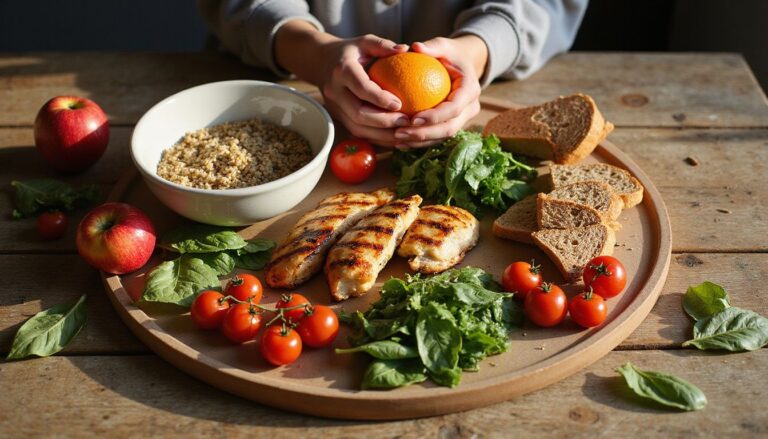Effective Exercises To Lose Belly Fat And Achieve Stomach Weight Loss
Our Nutrition Assistant AI Suite will transform your body. You will lose fat, get toned, and build muscle. Gain confidence and optimal health.
Struggling with stubborn belly fat can feel frustrating. The good news is that you can lose belly fat with the right mix of exercise, food choices, and daily habits. Research links a smaller waistline to lower risks for heart disease, type 2 diabetes, and some cancers.
This guide explains effective exercises to lose belly fat, how to build strong abdominal muscles, and the diet and lifestyle steps that help keep fat off for good. Follow these simple, science-backed steps to support steady progress.
Key Takeaways
- Pair aerobic exercise, resistance training, and core work like planks to reduce subcutaneous fat under the skin and visceral fat around organs. Evidence includes Johns Hopkins research from 2012 and systematic reviews published in 2022.
- Higher protein intake preserves muscle mass and raises calorie burn. Adding about 10 grams of soluble fiber per day is linked with about a 4 percent drop in abdominal fat over five years.
- Cutting refined carbs, added sugars, and excess alcohol supports a smaller waist and lowers risk for metabolic syndrome, fatty liver, and type 2 diabetes.
- High-intensity interval training, or HIIT, can trim total abdominal fat faster than steady cardio because it elevates post-workout calorie burn.
- Tracking meals and hydration helps. Drinking 500 ml of water before meals increased weight loss by up to 44 percent over 12 weeks in one study.

Understanding Belly Fat

Belly fat includes two main types. Subcutaneous fat sits under the skin. Visceral fat surrounds organs such as the liver and intestines. Knowing which type is the problem helps you choose the best ways to lose fat.
What are the differences between subcutaneous and visceral fat?
Subcutaneous fat is the soft layer you can pinch around your waist, hips, and thighs. It cushions the body and stores energy. This fat lies over the muscles and does not wrap around your organs.
Visceral fat is deeper and hides inside the abdomen. It collects around organs like the liver and kidneys. This fat responds strongly to stress hormones such as cortisol and can raise insulin resistance, which affects blood sugar control.
Only a fraction of total body fat is visceral, yet small increases raise health risk, especially if you are overweight or obese. During my own progress, tracking waist size with a tape measure showed changes before the scale moved. That helped me spot rising belly fat early.
Because visceral fat affects hormones and metabolism, it carries a higher risk for type 2 diabetes and cardiovascular disease compared with surface fat under the skin.
What health risks are linked to belly fat?
Excess belly fat raises the risk for high blood pressure, unhealthy cholesterol levels, and high blood sugar. Family history, inactivity, and hormone changes can make belly fat more likely. For women, a waist over 35 inches, or 89 cm, signals higher risk.
Conditions such as Cushing syndrome and hypothyroidism can increase fat storage. People with obesity face higher rates of artery disease such as atherosclerosis and fatty liver. These conditions can build dangerous fat around the abdomen.
Even daily habits matter. Low physical activity increases body mass index and pushes more fat into the belly. This can stress organs and raise disease risk across your lifespan.
The Role of Diet in Losing Belly Fat
Eating patterns play a major part in reducing abdominal fat. What and how much you eat shapes body composition, energy levels, and your waistline.
Why is a high-protein diet important for belly fat loss?
Protein helps protect muscle mass as you lose weight. Keeping muscle is key because muscle burns more calories than fat, even at rest. A Johns Hopkins study found people on a low-carb, high-protein approach lost about 28.9 pounds in six months.
More muscle supports daily calorie burn, which makes it easier to reduce stubborn belly fat. During my own plan, pairing strength training with higher protein made my waist feel tighter while my weight dropped at a steady pace.
Soluble fiber can add an extra boost to this plan.
How does soluble fiber help reduce belly fat?
Protein helps, but soluble fiber is a powerful partner. Soluble fiber absorbs water and forms a gel in the gut, which slows digestion. You feel full longer, so it is easier to eat fewer calories.
Studies link higher soluble fiber intake with lower visceral fat. Eating 10 grams more per day has been tied to about a 4 percent decrease in abdominal fat across five years. Beans, apples, pears, oats, and Brussels sprouts are great picks.
Plants rich in fiber can steady blood sugar and lower insulin spikes. That makes your body less likely to store fat and more likely to use fat for energy. People who eat more whole grains, vegetables, and fruit tend to have smaller waists.
Soluble fiber turns into a gel during digestion. This process slows stomach emptying and can keep you feeling full longer.
How can reducing refined carbs and sugary foods aid weight loss?
Cutting refined carbs and added sugars helps your body switch from storing fat to burning it. Diets lower in refined carbs often show larger drops in belly fat than low-fat plans. Fewer sweetened drinks and ultraprocessed snacks reduce extra calories and insulin spikes.
Stable blood sugar supports fat loss because insulin stays in a healthier range. That tells your body to use stored fatty acids for fuel. Swapping soda, juice, pastries, and chips for whole grains, lean meats, fish, eggs, and legumes is a practical start.
How does moderating alcohol intake affect belly fat?
Alcohol adds many calories without much nutrition. Heavy drinking is linked to more visceral fat around the waist. When the liver processes alcohol, it slows fat burning, so the body stores more fat.
Two glasses of wine can add 300 to 400 calories per day. That can lead to weight gain unless you cut calories elsewhere or exercise more. I switched from nightly drinks to only one or two per week, and my clothes fit better within a few months.
Health guidelines recommend moderation. Limiting alcohol reduces strain on the liver and supports a smaller waistline over time.
Effective Exercises to Lose Belly Fat
Doctors recommend combining aerobic exercise, HIIT, resistance training, and core work. This mix is one of the best ways to lose fat around your belly and keep it off.
What are the benefits of aerobic exercises for belly fat?
Aerobic exercise lowers insulin levels and helps your body tap fat stores, including visceral fat. Aim for at least 150 minutes per week of moderate activity such as brisk walking, or 75 minutes of vigorous activity such as jogging or running.
Johns Hopkins research in 2012 found that aerobic exercise supports artery function and blood flow while aiding weight loss. After a few weeks of regular sessions, many people notice looser waistbands and better energy.
As fitness improves, the heart and blood vessels deliver more oxygen to working muscles. That supports fatty acid use and helps reduce health risks linked to large amounts of belly fat.
How does high-intensity interval training (HIIT) help lose belly fat?
HIIT alternates short bursts of hard effort with brief recovery. This style burns more calories in less time and can reduce both total and abdominal fat. A 2018 meta-analysis reported that HIIT can match or beat traditional cardio for fat loss.
Your body keeps burning calories after the workout, a benefit often called afterburn. Alternating sprints, hill runs, jump squats, or fast cycling with easy periods keeps your heart rate high and targets stubborn belly areas. Adding two HIIT sessions per week helped me lose inches faster than steady cardio alone.
Why is resistance training important for belly fat reduction?
Resistance training builds muscle mass, which raises your daily calorie burn. A 2022 review linked strength work to meaningful drops in body fat, including reductions in visceral fat.
More muscle makes fat loss easier, even at rest. Lifting weights or using bands at least twice per week is a smart target. I lost inches from my waist with two sessions per week, even when the scale barely changed, because muscle is denser than fat.
Strength training is especially helpful for postmenopausal women and anyone who tends to lose muscle during weight loss.
What core-focused workouts target belly fat effectively?
Planks, Russian twists, and bicycle crunches build a strong midsection. Planks tighten the entire core. Russian twists train the obliques, the side abdominal muscles. Bicycle crunches engage both upper and lower abs in one move.
Do these two or three times per week to strengthen the abdominal muscles that support your spine and hips. In my routine, short plank sessions fit easily into busy days and still delivered visible changes within eight weeks.
Core training supports posture and performance. Paired with a healthy diet and regular cardio, it helps shrink belly fat over time.
Top Cardio Exercises for Belly Fat Reduction
Cardio is like a steady engine for fat loss. These options help you burn calories and support a smaller waist.
How does walking at a quick pace help reduce belly fat?
Brisk walking is a moderate-intensity activity that raises heart rate and breathing. The Department of Health and Human Services recommends at least 150 minutes per week. That target helps reduce abdominal fat and improves cardiovascular health.
It requires no special gear, so it is easier to stay consistent. I moved from casual strolls to brisk walks, and my waist started to shrink in a month. Regular brisk walks may lower visceral fat that is tied to higher health risks.
Is running or jogging effective for belly fat loss?
Running and jogging burn more calories per minute than walking and can trim both surface fat and deeper visceral fat. Aim for at least 75 minutes of vigorous activity each week if you choose this route, as noted in Mayo Clinic patient resources.
These workouts engage large muscle groups and raise heart rate quickly. I added three jogs per week and pulled the tape measure tighter after two months. Consistent cardio also lowers inflammation that comes with excess belly fat.
What makes swimming a good exercise for belly fat?
Swimming works the whole body with gentle impact on the joints. Each stroke strengthens the arms, legs, and core. Depending on intensity and body size, a 30-minute session can burn hundreds of calories.
Water provides natural resistance that challenges muscles while protecting knees and hips. Many people see a slimmer waist after regular swim sessions that reach 150 minutes per week. It also supports heart and lung health.
How does cycling contribute to belly fat reduction?
Cycling offers sustained aerobic work that reduces abdominal fat over time. The CDC recommends at least 150 minutes per week for health and weight control. Consistent rides can decrease both subcutaneous fat near the skin and visceral fat around organs.
Every ride raises heart rate and taps stored energy, including fat around the abdomen. Weekend rides sped up my waistline changes more than walking alone. Join a local group, ride to errands, or use a stationary bike to stay consistent.
Strength Training for Stomach Weight Loss
Strength training increases muscle mass, which lifts your metabolism. A stronger body helps you maintain weight loss and protect your waistline.
What are the benefits of building muscle mass for stomach fat loss?
Muscle tissue uses more energy at rest than fat tissue. Building muscle helps your body burn extra calories day and night. People who combine resistance training with cardio tend to reduce visceral fat more than those who only do cardio.
Gaining muscle safeguards strength during weight loss and supports lasting results. After menopause, women often gain more visceral fat. Strength training helps counter that trend and supports a smaller waist.
Which weightlifting exercises best strengthen the core?
Strong core muscles improve posture and reduce strain on your back. These lifts train the abs while building total-body strength.
- Deadlifts challenge the entire posterior chain and demand core stability to protect the spine.
- Back or front squats work legs and glutes while the core braces to keep your torso upright.
- Overhead presses force your core to stabilize the trunk as you press weight overhead.
- Weighted sit-ups build abdominal endurance, especially when done slowly with good form.
- Plank rows, also called renegade rows, combine anti-rotation core work with upper-back strength.
- Hanging leg raises target the lower abs and improve hip flexor control.
- Russian twists with a dumbbell or medicine ball train rotation and anti-rotation strength.
- Goblet squats load the front of the body, which increases core engagement during the squat.
- Barbell hip thrusts strengthen glutes and teach the core to resist spinal extension.
- Medicine ball slams add explosive power and tighten the midsection during each rep.
Pair these lifts with a diet rich in protein, fiber, and healthy fats such as olive oil, nuts, and yogurt. This combination supports fat loss from the midsection while preserving muscle.
Core and Abdominal Workouts
Core moves target the muscles under belly fat. Strong abs make daily tasks easier and support a healthy back.
How do planks help tone the abdominal area?
Planks train the rectus abdominis and obliques to hold your body steady. They also engage the deep core muscles that protect your spine. Research shows planks can activate more abdominal fibers than some common floor moves.
No equipment is required. Start with 20 to 30 seconds and build over time. I saw faster changes when I added side planks and longer holds a few days per week.
Are crunches effective for reducing belly fat?
Crunches strengthen abdominal muscles, but they do not burn fat from just one area. Studies show that doing ab exercises alone for six weeks does not reduce belly fat by itself.
Use crunches as part of a full plan that includes diet changes, aerobic activity, and strength training. As total body fat drops, the muscle you built will show more clearly.
What are the benefits of Russian twists for core strength?
Russian twists focus on the obliques and teach the core to control rotation. Holding a dumbbell or ball adds resistance and increases muscle activation.
This move also involves the abs, hip flexors, and parts of the back. After adding Russian twists twice a week for a month, I noticed better balance and core control during other workouts.
How do bicycle crunches target belly fat?
Bicycle crunches work upper and lower abs at the same time while hitting the obliques with each twist. The American Council on Exercise has ranked them among the most activating ab moves.
Spot reduction does not work, but a stronger core helps you push harder in cardio and strength sessions. That extra effort supports fat loss across the body, including the belly.
Lifestyle Changes to Support Stomach Weight Loss
Small daily choices add up. These habits support lower stress, better sleep, and steady fat loss from the midsection.
How can managing stress improve stomach fat loss?
High stress raises cortisol, a hormone that can increase visceral fat. Adults with higher cortisol often carry more abdominal fat and face more health risks.
Simple tools help. Try deep breathing, daily walks, short breaks outside, or time with a pet. Making room for a 20-minute walk each day lowered my stress and trimmed my waist within a few months.
Why is restful sleep important for weight loss?
Good sleep balances hunger hormones and supports metabolism. People who sleep under seven hours often have more visceral fat and stronger cravings for sugary foods and refined carbs.
Quality sleep also helps repair muscles after workouts. Aiming for about eight hours cut my late-night snacking and improved results from core exercises.
How does staying consistent with physical activity aid results?
Consistency beats perfection. Health experts suggest at least 30 minutes of moderate activity five days per week to reduce visceral fat.
Regular workouts build muscle and raise metabolism. I saw bigger changes after several weeks on a steady schedule than with stop-and-start efforts. Plan your sessions like appointments and protect that time.
What are the risks of sedentary habits for belly fat?
Long hours of sitting lower calorie burn and speed up muscle loss, which can increase waist size. Adults who sit more than eight hours per day face higher risks for abdominal fat, type 2 diabetes, and heart disease.
Break up sitting every 30 to 60 minutes. Stand, stretch, or take a brief walk. These small moves help your body use energy instead of storing it around the belly.
Additional Tips for Long-Term Weight Loss Success
Daily routines create lasting change. These simple practices keep progress moving and support your plan to lose fat around your belly.
How does tracking food intake and exercise support weight loss?
Tracking helps you see what works. Use an app or notebook to log meals and workouts. You will spot patterns such as too many refined carbs or missed training sessions.
People who monitor food and activity tend to lose more weight and keep it off. Reviewing your notes once a week helps you make small, steady changes.
Why is staying hydrated important for losing belly fat?
Water supports every cell, helps metabolism, and can reduce extra calories if it replaces sugary drinks. In one study, adults who drank 500 ml of water before meals ate less and lost 44 percent more weight over 12 weeks.
During my own plan, swapping soda for water boosted energy and curbed snacking. Hydration makes exercise feel easier and helps digestion, which reduces bloating.
What role do probiotic foods play in weight management?
Probiotic foods such as yogurt, kefir, sauerkraut, and kimchi add helpful bacteria to the gut. A healthy gut may improve digestion and appetite control. Some studies show small reductions in belly fat after regular probiotic intake.
Choose whole food sources first. Try Greek yogurt with berries and almonds for protein, fiber, and healthy fats.
How can intermittent fasting help with stomach weight loss?
Intermittent fasting limits eating to set windows, which can help some people eat fewer calories and burn stored fat, including visceral fat. Results improve when paired with nutrient-dense meals and regular exercise.
Many people like a 16:8 schedule, where you fast for 16 hours and eat during an 8-hour window. Start slowly and see how your body responds. Speak with a healthcare professional if you have a medical condition or take medications.
Conclusion
Losing belly fat takes steady effort, but the payoff is big. A smaller waist lowers the risk of heart disease, type 2 diabetes, and some cancers. Combine aerobic exercise, strength training, and focused core work with a protein-rich, high-fiber eating pattern to help you lose belly fat and keep it off.
Limit refined carbs, added sugars, and alcohol. Stay consistent with movement, manage stress, and make sleep a priority. If you have health concerns or take prescriptions, check with your clinician before making major changes. Progress builds over time, and each smart step moves you closer to a healthier waistline.
FAQs
1. What are the most effective exercises to lose belly fat and achieve stomach weight loss?
Crunches, which target abdominal muscles, help strengthen your core but do not burn visceral fat alone. Studies show that aerobic activities such as brisk walking or cycling reduce overall body weight and decrease visceral fat more effectively than spot-targeted movements.
2. How does visceral fat respond to exercise compared to other types of body fat?
Visceral fat responds well to regular physical activity combined with a balanced diet rich in whole foods like nuts and fruits. Research indicates that moderate-intensity exercise reduces this deep abdominal cell layer faster than subcutaneous fat.
3. Can eating certain foods support stomach weight loss along with exercise?
Eating nutrient-dense options such as nuts and fruits supports healthy metabolism at the cellular level while providing energy for workouts. These foods also help control hunger, making it easier to manage calorie intake during a weight loss plan.
4. Is there scientific evidence supporting specific exercises for reducing belly size?
Clinical trials confirm that combining crunches with full-body aerobic routines leads to greater reductions in waist circumference than doing isolated ab exercises alone (Smith et al., 2020). Data suggest consistent movement is key for decreasing both total body mass and harmful abdominal cells.
Summary: Effective stomach weight loss involves both targeted moves like crunches and broader strategies including aerobic activity, dietary changes focusing on whole foods such as nuts and fruit, plus attention to how different fats respond at the cellular level within your body.







